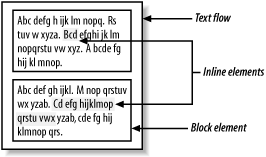Narrative Documents
Now let’s look at an important category of XML. A narrative document contains text meant to be read by people rather than machines. Web pages, books, journals, articles, and essays are all narrative documents. These documents have some common traits. First, order of elements is inviolate. Try reading a book backward and you’ll agree it’s much less interesting that way (and it gives away the ending). The text runs in a single path called a flow, which the reader follows from beginning to end.
Another key feature of narrative documents is specialized element groups, including sections, blocks, and inlines. Sections are what you would imagine: elements that break up the document into parts like chapters, subsections, and so on. Blocks are rectangular regions such as titles and paragraphs. Inlines are strings inside those blocks specially marked for formatting. Figure 3-2 shows how a typical formatted document would render these elements.
 |
Flows and Sections
A narrative document contains at least one flow, a stream of text to be read continuously from start to finish. If there are multiple flows, one will be dominant, branching occasionally into short tangential flows like sidebars, notes, tips, warnings, footnotes, and so on. The main flow is typically formatted as a column, while other flows are often in boxes interrupting the ...
Get Learning XML, 2nd Edition now with the O’Reilly learning platform.
O’Reilly members experience books, live events, courses curated by job role, and more from O’Reilly and nearly 200 top publishers.

